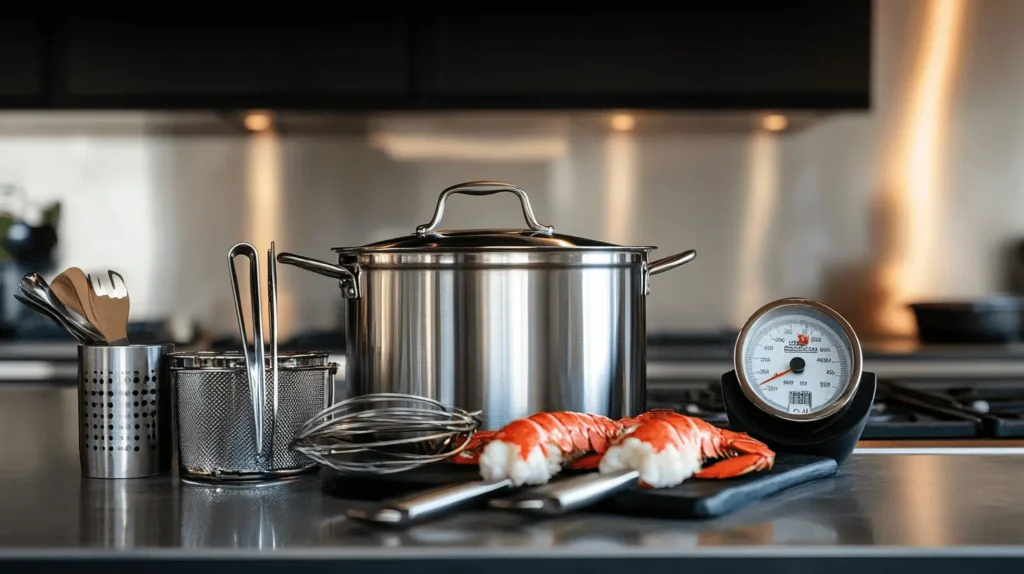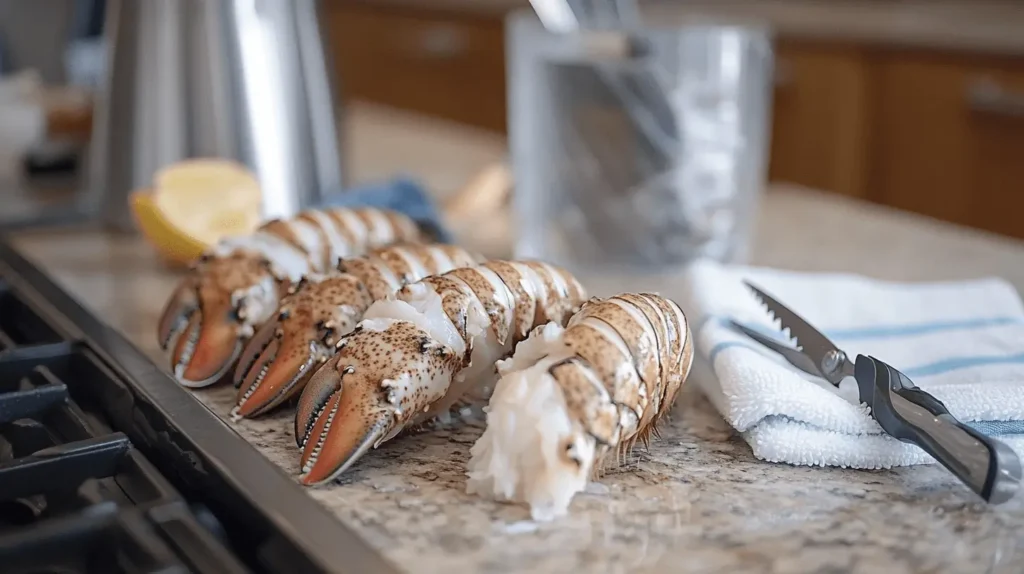Introduction to Steaming Lobster Tails
Steaming is a popular and time-honored method for cooking lobster tails, celebrated for its ability to preserve the natural sweetness and tenderness of the lobster meat. This cooking technique is not only simple and efficient but also ensures that the delicate flavors of the lobster remain intact, making it a preferred choice among seafood enthusiasts.
Why Steaming is Popular for Cooking Lobster Tails
Steaming lobster tails has gained widespread popularity for several reasons:
- Preservation of Natural Flavor: Unlike boiling, which can dilute the flavor of the meat, steaming allows the lobster to cook gently in its own juices, enhancing its natural sweetness and rich taste.
- Even Cooking: The steaming process surrounds the lobster tails with hot vapor, cooking them evenly without drying out or overcooking any part.
- Nutrient Retention: Steaming helps retain more nutrients compared to other methods like frying or grilling, making it a healthier option for seafood lovers.
- Ease and Efficiency: With minimal equipment and effort required, steaming is a straightforward and effective way to prepare lobster tails, even for beginners.
The Perfect Texture and Flavor Achieved Through Steaming
When done correctly, steaming produces lobster tails with a texture that is both tender and succulent, offering a melt-in-your-mouth experience. The gentle heat ensures that the meat stays firm without becoming rubbery, while the process locks in moisture to prevent dryness.
The steaming method also allows for the infusion of subtle flavors if aromatic ingredients like lemon slices, garlic, or herbs are added to the water. This can elevate the overall taste, creating a delightful blend of natural lobster sweetness and complementary seasonings.
Whether served with a side of melted butter, a squeeze of fresh lemon, or as part of a more elaborate dish, steamed lobster tails are a gourmet delight that highlights the best qualities of this prized seafood delicacy.
Essential Tools and Equipment
Preparing perfect steamed lobster tails requires the right tools and equipment to ensure optimal results. From achieving even cooking to maintaining food safety, these tools will help make the process smooth and successful.

Steamer Basket and Alternatives
The steamer basket is a quintessential tool for steaming lobster tails. It holds the lobster above the water, allowing the steam to circulate evenly around the tails. This ensures they cook gently and retain their delicate flavor and texture.
- Traditional Steamer Basket: Made of stainless steel or bamboo, these baskets fit inside pots and provide a sturdy platform for the lobster.
- Collapsible Steamer Insert: A space-saving alternative, collapsible inserts fit various pot sizes and are easy to store.
- DIY Alternatives: If you don’t have a steamer basket, you can improvise by placing a metal colander or sieve over a pot of boiling water. Another option is to use a small rack or inverted heatproof plate placed in the pot with water just below the surface.
Selecting the Right Pot
Choosing the appropriate pot is crucial for effective steaming.
- Size and Capacity: The pot should be large enough to hold the steamer basket or alternative and allow space for the steam to circulate freely around the lobster tails.
- Tight-Fitting Lid: A lid that seals tightly helps trap steam and maintain consistent cooking temperatures, ensuring the lobster tails cook evenly.
- Material: Opt for pots made of durable materials such as stainless steel or aluminum, which conduct heat efficiently and evenly.
Thermometer for Temperature Accuracy
A reliable food thermometer is an invaluable tool for ensuring that the lobster tails are cooked to perfection. Proper internal temperature is essential for food safety and achieving the ideal texture.
- Measuring Internal Temperature: The internal temperature of cooked lobster tails should reach 140°F (60°C) to ensure they are fully cooked without being overdone.
- Steam Temperature Check: A thermometer can also help monitor the water or steam temperature during cooking to maintain consistent heat.
By equipping yourself with these essential tools and understanding their use, you can confidently prepare steamed lobster tails that are tender, flavorful, and beautifully cooked every time.
Preparing Lobster Tails for Steaming
Proper preparation of lobster tails is key to achieving a delicious and perfectly cooked dish. From thawing to cleaning and trimming, following these steps ensures that your lobster tails are ready for steaming.

How to Thaw Frozen Lobster Tails
If your lobster tails are frozen, they must be properly thawed to ensure even cooking and preserve their natural flavor and texture.
- Refrigerator Method (Recommended): Place the frozen lobster tails in a bowl or on a plate, cover them, and leave them in the refrigerator for 12-24 hours. This slow thawing method helps maintain the quality of the meat.
- Cold Water Method: If you’re short on time, submerge the lobster tails in a sealed plastic bag in cold water. Change the water every 30 minutes, and the tails should thaw in 1-2 hours.
- Avoid Microwave Thawing: Using a microwave can partially cook the tails, leading to uneven results when steaming.
Cleaning and Deveining Lobster Tails
Cleaning the lobster tails ensures they are free from any sand, grit, or digestive matter.
- Rinse Under Cold Water: Gently rinse the lobster tails under cold running water to remove any surface debris.
- Remove the Vein:
- Use kitchen shears to cut along the top of the shell, exposing the vein running along the back of the tail.
- Pull out the vein with your fingers or the tip of a knife and discard it.
- Pat Dry: Use a clean kitchen towel or paper towels to pat the tails dry, preparing them for trimming and steaming.
Trimming and Prepping the Shell
Prepping the lobster shell not only makes it easier to eat but also helps ensure even cooking.
- Cutting the Shell:
- With kitchen shears, cut lengthwise down the top of the shell, stopping just before the tail fin.
- Avoid cutting the meat while trimming the shell.
- Loosening the Meat:
- Carefully lift the lobster meat through the slit, resting it on top of the shell while keeping it attached at the base. This method, called “butterflying,” allows for more even steaming and an attractive presentation.
- Trimming Sharp Edges:
- Use scissors or a knife to trim any sharp edges or small spines on the shell to prevent injury while handling or serving.
By thoroughly thawing, cleaning, and prepping the lobster tails, you set the stage for a delightful and visually appealing dish that will impress any seafood lover.
Determining Steaming Time Based on Weight
The weight of lobster tails plays a crucial role in determining the ideal steaming time. Proper timing ensures the meat is cooked through while retaining its tender, juicy texture. Overcooking can lead to tough and rubbery lobster meat, so it’s important to follow weight-based guidelines.
Steaming Times for Small Lobster Tails (4-6 oz)
For small lobster tails weighing 4-6 ounces, the recommended steaming time is relatively short due to their size. Follow these guidelines for perfectly cooked lobster:
- Preheat the Steamer: Bring the water in your pot to a rolling boil, and ensure the steam is flowing before adding the lobster tails.
- Set the Timer: Place the lobster tails in the steamer basket or on a steaming rack, ensuring they are not submerged in water. Cover the pot with a tight-fitting lid to trap the steam.
- Cook Time: Steam the lobster tails for 5-7 minutes, depending on their exact weight:
- 4 oz: Steam for approximately 5-6 minutes.
- 5-6 oz: Steam for approximately 6-7 minutes.
- Check for Doneness: The lobster meat should turn opaque and white, with a firm texture. The shell will turn bright red. To confirm doneness, use a food thermometer to check the internal temperature, which should reach 140°F (60°C).
Tips for Best Results:
- Avoid overcrowding the steamer, as this can hinder even cooking.
- If steaming multiple lobster tails, ensure they are of similar size for consistent results.
- Serve immediately for the best flavor and texture.
By following these guidelines, you can ensure small lobster tails are steamed to perfection, offering a delicate and flavorful seafood experience.
Factors That Influence Steaming Time
Several factors can influence the steaming time for lobster tails, impacting how long it takes to achieve perfectly cooked meat. Understanding these variables ensures consistent results and avoids overcooking or undercooking your lobster tails.
Frozen vs. Fresh Lobster Tails
The condition of the lobster tails—whether frozen or fresh—directly affects steaming time:
- Frozen Lobster Tails: If the tails are not completely thawed before steaming, they will require additional time to cook through. For best results, always fully thaw frozen lobster tails to ensure even cooking. Partially thawed tails may need an extra 1-2 minutes of steaming time.
- Fresh Lobster Tails: Fresh lobster tails, which are not frozen, cook faster and more uniformly. Their natural moisture content and texture make them ideal for achieving tender, juicy results within standard steaming times.
Altitude and Its Impact on Cooking
Cooking at high altitudes can affect steaming times due to changes in atmospheric pressure:
- At higher elevations, water boils at a lower temperature, producing less intense steam. This may require slightly longer cooking times for lobster tails to reach the desired internal temperature.
- As a general rule, add an extra 1-2 minutes to the steaming time if you are cooking at altitudes above 3,000 feet.
Variations in Shell Thickness
The thickness of the lobster shell also plays a role in determining how long the tails need to steam:
- Thin-Shelled Lobsters: Lobsters with thinner shells allow heat to penetrate more quickly, reducing the cooking time slightly. Monitor closely to avoid overcooking.
- Thick-Shelled Lobsters: Thicker shells take longer to heat through and may require an additional 1-2 minutes of steaming time, particularly for larger tails.
By accounting for these factors, you can confidently adjust steaming times to create a perfectly cooked lobster tail that is tender, juicy, and flavorful.
Step-by-Step Guide to Steaming Lobster Tails
Steaming lobster tails is a simple yet effective method that ensures tender, flavorful results. Follow these detailed steps to master the process.
Step 1: Preparing Your Equipment
Start by setting up everything you need to ensure a smooth and efficient cooking process.
- Gather Your Tools: You’ll need a large pot with a tight-fitting lid, a steamer basket or alternative (e.g., colander, steaming rack), and tongs for handling the hot lobster tails.
- Fill the Pot with Water: Add about 1-2 inches of water to the pot—just enough to create steam without touching the lobster tails.
- Add Aromatics (Optional): Enhance the flavor by adding lemon slices, garlic, or herbs like bay leaves to the water.
Step 2: Preheating the Steamer
Before steaming the lobster tails, ensure your steamer is properly preheated.
- Heat the Water: Place the pot on the stove over high heat and bring the water to a rolling boil.
- Create Steam: Once boiling, reduce the heat slightly to maintain a steady flow of steam.
Step 3: Steaming the Lobster Tails
Now it’s time to steam the lobster tails to perfection.
- Place the Tails in the Steamer: Arrange the lobster tails in the steamer basket, ensuring they don’t overlap or touch the water.
- Cover the Pot: Secure the lid tightly to trap the steam.
- Set the Timer: Steam according to the weight of the tails:
- 4-6 oz tails: Steam for 5-7 minutes.
- Larger tails may require 8-12 minutes.
- Monitor the Process: Resist the urge to lift the lid frequently, as this releases steam and slows cooking.
Step 4: Checking for Doneness
Properly cooked lobster tails will have a tender texture and a sweet flavor. Here’s how to confirm they’re done:
- Visual Cues: The lobster shells should turn bright red, and the meat should be opaque white and firm to the touch.
- Internal Temperature: Use a food thermometer to check the thickest part of the meat. The internal temperature should reach 140°F (60°C).
- Avoid Overcooking: If the meat appears rubbery or dry, it has been overcooked. Remove the tails promptly once they’re done.
Final Tip:
Serve the steamed lobster tails immediately, garnished with melted butter, lemon wedges, or your favorite dipping sauce for a gourmet dining experience. This step-by-step guide will help you achieve perfectly steamed lobster tails every time.

How to Tell If Lobster Tails Are Fully Cooked
Cooking lobster tails to perfection requires attention to detail and knowing when they are fully cooked. Properly cooked lobster tails are tender, juicy, and bursting with flavor. Here’s how to tell when they’re done.
Visual Cues: Color and Texture
- Shell Color:
- The lobster shell will transform from its raw, dark color (typically green, blue, or brown) to a bright, vibrant red when fully cooked. This change is one of the easiest ways to identify doneness.
- Meat Color:
- The meat should appear opaque and white. Any translucent or grayish areas indicate that the lobster is undercooked and needs more steaming time.
- Texture:
- Properly cooked lobster meat is firm but not tough or rubbery. It should easily pull away from the shell and have a smooth, velvety texture.
Using a Meat Thermometer
For the most accurate assessment, use a meat thermometer to check the internal temperature of the steamed lobster tails:
- Insert the Thermometer: Place the thermometer probe into the thickest part of the lobster tail meat, avoiding the shell.
- Target Temperature: The lobster tails are fully cooked when the internal temperature reaches 140°F (60°C).
- Instant-Read Thermometers: These are ideal for quickly checking the temperature without losing too much heat from the steam.
By using these methods, you can ensure that your lobster tails are perfectly cooked—tender, flavorful, and ready to impress your guests.
FAQs About Steaming Lobster Tails
Steaming lobster tails is a popular cooking method, but you may have questions about achieving the best results. Here are answers to some frequently asked questions.
How Long to Steam Lobster Tails?
The steaming time depends on the size of the lobster tails:
- 4-6 oz tails: Steam for 5-7 minutes.
- 6-8 oz tails: Steam for 8-10 minutes.
- Larger tails may take 10-12 minutes. Always check for doneness by observing visual cues or using a thermometer to ensure the internal temperature reaches 140°F (60°C).
Can You Oversteam Lobster Tails?
Yes, oversteaming lobster tails can cause the meat to become tough, rubbery, and less flavorful. To avoid this:
- Follow weight-based steaming times.
- Check the lobster frequently as it nears the end of the cooking time.
- Remove the tails from the steamer immediately once they’re done.
What’s the Best Way to Defrost Lobster Tails?
The best way to defrost lobster tails is gradually in the refrigerator:
- Place the tails in a bowl or on a plate, cover them, and let them thaw in the fridge for 12-24 hours. For a quicker option, place the tails in a sealed plastic bag and submerge them in cold water, changing the water every 30 minutes. Avoid using a microwave, as it can partially cook the meat.
Should You Season Before or After Steaming?
You can do either, depending on your preference:
- Before Steaming: Add flavor by brushing the meat with melted butter, lemon juice, or seasoning before steaming.
- After Steaming: Season the meat immediately after steaming with melted butter, herbs, or a sprinkle of seasoning for a fresh, vibrant taste. Adding aromatics like lemon slices, garlic, or herbs to the steaming water also enhances the flavor.
These FAQs provide guidance to help you confidently steam lobster tails to perfection, ensuring a delicious and satisfying seafood experience.
Conclusion: Perfectly Steamed Lobster Tails Every Time
Steaming lobster tails is an easy and rewarding way to prepare this luxurious seafood delicacy. By following the steps and tips outlined, you can consistently achieve tender, flavorful, and perfectly cooked lobster tails every time.
Recap of Key Tips
- Preparation is Key: Thaw, clean, and prep your lobster tails properly to ensure even cooking and enhance flavor.
- Use the Right Tools: A steamer basket, the right pot, and a food thermometer are essential for success.
- Timing Matters: Follow weight-based steaming times, typically 5-7 minutes for 4-6 oz tails, and check for doneness using visual cues and a thermometer.
- Avoid Overcooking: Remove the tails immediately after cooking to maintain their tender, juicy texture.
- Enhance Flavor: Use seasonings, melted butter, or aromatics to add extra depth and deliciousness to your lobster.
Encouragement to Experiment and Enjoy
Don’t be afraid to experiment with flavors and pairings to make the dish your own. Add fresh herbs, spices, or a splash of lemon to personalize the experience. Pair your perfectly steamed lobster tails with sides like garlic butter, steamed vegetables, or a crisp salad for a complete meal.
Enjoy the process of preparing and savoring this exquisite dish, and share it with friends and family for a memorable dining experience. With these tips and a little practice, you’ll be steaming lobster tails like a pro in no time!


1 thought on “How Long To Steam Lobster Tails?”